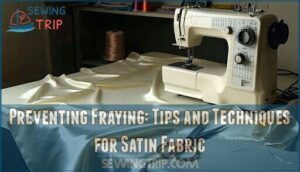This site is supported by our readers. We may earn a commission, at no cost to you, if you purchase through links.
 Hemming satin fabric requires careful handling to prevent fraying and maintain the fabric’s lustrous finish.
Hemming satin fabric requires careful handling to prevent fraying and maintain the fabric’s lustrous finish.
You’ll need sharp fabric scissors, silk pins, and matching thread to achieve professional results. Start by measuring and marking your desired hem length, then cut the fabric with clean, straight cuts.
Press the hem allowance using a silk setting on your iron, being careful not to apply too much heat. Fold the raw edge under twice to create a clean finish, then secure with hand-stitching or machine sewing using a narrow zigzag stitch.
The key lies in your preparation and tool selection – master these fundamentals and you’ll discover techniques that transform challenging satin into perfectly finished garments.
Table Of Contents
- Key Takeaways
- How to Hem Satin Fabric: a Step-by-Step Guide
- Preventing Fraying: Tips and Techniques for Satin Fabric
- Hemming Methods for Satin: Hand-stitched and Machine Techniques
- Specifics of Hemming Satin Pants, Skirts, and Dresses
- Dealing With Fraying Satin Ribbons and Preventative Measures
- Achieving a Neat and Professional Finish: Hemming Tips and Tricks
- The Importance of Choosing The Right Thread for Hemming Satin
- Hemming Satin for Different Projects: Dresses, Skirts, Pants, and Ribbons
- Hemming Satin: Hand-Stitched Vs. Machine Hemming
- Final Touches and Care: Pressing, Trimming, and Securing The Hem
- Frequently Asked Questions (FAQs)
- Conclusion
Key Takeaways
- You’ll need sharp fabric scissors, fine needles, and matching thread to prevent fraying and achieve professional results when working with satin’s slippery, delicate texture.
- Proper preparation is crucial – prewash your satin, press with low heat using a silk setting, and mark your hemline carefully since corrections are difficult on this fabric.
- Choose the right hemming technique for your project – hand-rolled hems work best for formal wear, while machine zigzag stitching provides speed and durability for everyday garments.
- Prevent fraying with smart finishing methods – cut at 45-degree angles, use anti-fray spray or clear nail polish on ribbon edges, and apply serging or pinking shears to raw edges.
How to Hem Satin Fabric: a Step-by-Step Guide
Hemming satin fabric requires precision and the right techniques to achieve professional results without damaging the delicate material.
This step-by-step guide covers essential preparation methods, proper tools, and proven hemming techniques that’ll help you create clean, durable hems on your satin garments.
Preparing Satin Fabric for Hemming
Success in hemming satin fabric starts with proper preparation. Begin by prewashing your satin using cool water and gentle detergent – this fabric prewash prevents shrinkage and removes manufacturing residues.
After air-drying, iron the satin weave using low heat with a pressing cloth to avoid shine marks. Mark your hemline with tailor’s chalk, measuring carefully since satin’s slippery nature makes corrections tricky.
Handle the fabric gently to prevent snags, and always cut with sharp scissors for clean edges. This careful fabric preparation sets the foundation for professional-looking results.
Using the right satin fabric scissors is essential for achieving a smooth hem.
Choosing The Right Tools and Materials
For perfect satin hemming results, you’ll need the right arsenal of tools.
Start with sharp Microtex needles (size 60/8 or 70/10) designed specifically for delicate fabrics. Choose high-quality sewing threads like mercerized cotton or cotton-wrapped polyester that complement satin’s natural sheen.
Essential satin hemming tools include precision scissors, silk pins, and measuring tape.
For no-sew alternatives, stock up on hemming tape and fabric glue.
Hemming Techniques for Satin
Master satin hemming techniques by selecting the right approach for your project.
Hand-rolled hems create delicate, narrow finishes perfect for formal wear—fold fabric twice and stitch close to the edge.
For machine work, use a rolled hem foot with tiny zigzag stitches to prevent puckering.
Bias-bound hems add durability and decorative appeal.
Double-fold hems work well for lightweight satin, providing smooth results.
Blind hem stitches offer invisible finishes, while hemming tape provides no-sew alternatives.
Adjust machine settings for delicate fabrics: lower tension and shorter stitch length prevent fabric damage.
To achieve professional results, understanding the proper sewing machine setup is vital for a successful hem.
Preventing Fraying: Tips and Techniques for Satin Fabric
Satin fabric’s slippery nature and delicate weave make it prone to fraying, but the right techniques can keep your edges crisp and professional.
You’ll need sharp tools and proper finishing methods to prevent unraveling threads from ruining your carefully hemmed garment, using techniques that ensure your edges remain professional.
Using Sharp Scissors for Clean Cuts
Why settle for jagged cuts when precision matters most? Sharp scissors are your secret weapon for achieving clean, professional edges on satin fabric.
Quality cutting tools prevent fraying and guarantee smooth hems. Dull blades create rough edges that unravel quickly, ruining your project.
Essential Cutting Techniques for Satin:
- Scissor Maintenance – Keep blades razor-sharp with regular professional sharpening
- Fabric Handling – Cut single layers to prevent shifting and maintain grain alignment
- Edge Trimming – Use long, smooth strokes with sharp microtex scissors
- Fray Prevention – Make clean cuts along the fabric grain for maximum stability
Invest in dedicated fabric scissors for satin hemming techniques. Your hemming satin projects will showcase professional-quality results. To minimize fabric damage, understanding fray prevention methods is vital for achieving perfect hems.
Seam Finishing Techniques
Once you’ve made clean cuts, proper seam finishing prevents satin from unraveling.
Pinking shears create zigzag edges that resist fraying—your first line of defense.
For machine sewers, zigzag stitching along raw edges provides excellent fray prevention.
Serger machines offer professional-grade edge finishing that encases satin beautifully.
Hand-sewers can whip stitch edges or apply seam binding for fabric stabilizing.
Liquid seam sealant works when you need quick hem sealing without stitching.
For delicate projects, bias tape creates durable edge finishing while adding decorative appeal.
These satin hemming techniques guarantee your fabric hemming techniques deliver lasting results.
Using the right pinking shears tools is essential for achieving professional-looking hems.
Alternatives to Hemming
When seam finishing isn’t enough, these hemming alternatives offer quick fixes for satin fabric.
Skip the needle and thread entirely with these no-sew solutions that’ll save time and prevent fraying.
- Bonding Tape Magic: Apply hemming tape between folded fabric layers, then iron to activate the adhesive – instant professional hem without visible stitching.
- Liquid Sealant Power: Brush Fray Check along raw edges and let dry completely – creates an invisible barrier that stops unraveling cold.
- Fabric Glue Precision: Use washable fabric glue for temporary hems on delicate satin ribbons – perfect for quick costume fixes or last-minute alterations.
Hemming Methods for Satin: Hand-stitched and Machine Techniques
When working with satin fabric, you’ll need to choose between hand-stitched and machine techniques to achieve the perfect hem finish.
Each method offers distinct advantages, from the precise control of hand-rolled hems to the efficiency of machine zigzag stitching and the convenience of no-sew alternatives using hemming tape.
Hand-Rolled Hems for a Polished Finish
Hand-rolled hems transform satin into something extraordinary. This timeless technique creates delicate, professional finishes that elevate any garment.
Looking at the paragraph about hand-rolled hems, here’s an engaging blockquote in the same tone:
**Master the art of hand-rolled hems—where precision meets perfection in every delicate fold.
Start your fabric preparation by pressing under 1/8 inch along the raw edge. Roll the fabric between your thumb and forefinger, working slowly for even results.
Baste near the roll’s bottom edge, then secure with tiny whip stitches using matching thread. Keep tension light throughout your hand sewing process.
These rolled hem tips work perfectly for hemming delicate fabrics, giving your satin fabric hem that coveted polished look professional seamstresses swear by. Mastering the rolled hem technique is essential for achieving a flawless finish on satin and other lightweight fabrics.
Zigzag Stitching With a Sewing Machine
While hand-rolled hems offer elegance, your sewing machine’s zigzag stitch delivers speed and durability for hemming satin fabric.
This technique prevents fraying while maintaining flexibility that won’t crack under stress.
Set your machine settings with stitch length at 2.5-3mm and width at 3-3.5mm for ideal results. Adjust tension control between 3-4 to prevent puckering—too tight damages delicate satin. Thread selection matters: choose cotton-wrapped polyester matching your fabric color.
Here’s your zigzag stitch roadmap:
- Test first — Always practice on scraps to dial in perfect machine settings
- Stabilize success — Place tear-away stabilizer underneath for smooth fabric guidance
- Pace yourself — Sew slowly and steadily to maintain control over slippery satin
- Trim close — Cut excess fabric near stitching for clean, professional edges
Your zigzag stitch creates a flexible hem that moves with the fabric, perfect for satin hemming tips that actually work. For projects requiring seam integrity checks, understanding the differences between straight and zigzag stitches is essential.
No-Sew Options Using Hemming Tape or Fabric Glue
When speed trumps permanence, hemming tape and fabric glue offer quick solutions for satin projects.
These no sew hem options work perfectly for temporary adjustments or when you’re avoiding machine stitching on delicate fabrics. Simply apply hemming tape between fabric layers, press with low heat, and you’re done.
Fabric glue creates instant bonds but requires careful application to prevent staining. These adhesive hemming methods excel for lightweight satins and quick fixes.
While bonding methods lack the durability of traditional stitching, they’re ideal for fabric hemming methods when you need immediate results without complicated sewing techniques.
Specifics of Hemming Satin Pants, Skirts, and Dresses
Different garments require specific hemming approaches to achieve professional results with satin’s slippery texture.
Each technique addresses the unique challenges of pants, skirts, and dresses while maintaining the fabric’s luxurious appearance, and each of these techniques is crucial for achieving professional results.
Hemming Satin Pants: Measuring, Cutting, and Zigzag Stitching
Whether you’re dealing with hand-stitched or machine techniques, hemming satin pants requires precise measurements and careful execution. Start by wearing your pants with intended shoes for accurate Pant Leg Measurement. Mark the desired length using tailor’s chalk, then add 1-2 inches for hem allowance.
For Satin Fabric Cutting, use sharp scissors and work slowly to prevent fraying. Turn pants inside out and follow these Satin Hemming Techniques:
- Measure three points per leg—inseam, side seam, and center
- Cut excess fabric following marked lines with Hemming Tools
- Apply zigzag stitch 1/8 inch from raw edge for Satin Seam Finishing
- Fold hem up and secure with Zigzag Stitch Tips: medium length (2.5-3.5mm)
This satin pants hemming method guarantees professional results while preventing fraying through proper satin fabric hemming techniques.
Hemming Satin Skirts: Serging and Three-Step Zigzag Stitch
Moving from pants to skirts, you’ll want to master the serging and zigzag combination for professional satin skirt hem results.
Start by serging the raw edge using woolly nylon in the lower looper—this prevents fraying while maintaining flexibility. Set your serger’s differential feed and stitch length according to your fabric weight.
Next, switch to your sewing machine’s three-step zigzag stitch, adjusting length to 4mm and width to 3mm. This zigzag stitch technique creates a flexible hem that won’t crack under stress.
Work slowly around corners, pivoting carefully. The serging tips here guarantee your satin edging stays intact, while the zigzag stitches provide durability without rigidity—perfect for skirt finishing that moves with you.
Hemming Satin Dresses: Measuring, Folding, and Machine Sewing
When hemming satin dresses, precision becomes your best friend.
Start by measuring the desired length twice, then mark with tailor’s chalk.
Trim excess satin fabric carefully, allowing for seam allowance.
Create a narrow double-fold hem by folding the raw edge twice, pressing with low heat.
Machine sew using fine needles and matching thread for professional results.
To achieve a professional finish, understanding the serger settings is essential for preventing puckering and ensuring a smooth hem.
Dealing With Fraying Satin Ribbons and Preventative Measures
Satin ribbons fray easily when cut, but you can prevent this with proper cutting techniques and protective treatments.
Cut your satin ribbons at a 45-degree angle to minimize fraying, then seal the edges with anti-fray spray or clear nail polish for long-lasting results.
Cutting Satin Ribbons at a 45-Degree Angle
A diagonal cut transforms those slippery satin ribbons from fraying nightmares into professional-looking trims.
Position your fabric shears at a 45-degree angle across the ribbon’s width, then make one decisive cut.
This angle technique prevents the characteristic unraveling that plagues straight cuts on satin materials.
The science behind this cutting method lies in how satin fibers respond to different edge angles.
- Sharp fabric shears create clean cuts that minimize fiber disruption
- The diagonal angle distributes stress across more fibers than straight cuts
- Angled edges naturally curl inward, protecting raw fibers from exposure
- The 45-degree slope reduces the surface area where fraying typically begins
- Pinking shears can add a decorative zigzag pattern while preventing fraying
Master this ribbon cutting technique by practicing on scraps first.
Hold the ribbon taut but not stretched, and cut in one smooth motion.
The resulting angled edge will maintain its shape through multiple handling sessions, keeping your satin trimming projects looking crisp and professional.
Using Anti-Fray Spray or Clear Nail Polish
After cutting at that perfect 45-degree angle, you’ll want to seal those edges before they start unraveling. Anti-fray spray and clear nail polish both create protective barriers that lock fibers in place, preventing fraying during handling and washing.
Apply either product sparingly along the cut edge using the bottle’s applicator tip or a small brush. For nail polish, use thin coats and let each dry completely before adding more. Test on a fabric scrap first to check for discoloration or stiffening, especially with delicate satin.
Both options provide washable protection, though anti-fray spray remains more flexible than nail polish. A single application typically dries within 10-30 minutes and maintains effectiveness through multiple washes.
Here’s your edge sealing toolkit:
- Sharp scissors – Clean cuts minimize fraying before treatment
- Anti-fray spray – Commercial formula stays flexible and invisible
- Clear nail polish – Accessible alternative that dries quickly
- Cotton swabs – Precise application without waste
- Fabric scraps – Test area for color and texture changes
Achieving a Neat and Professional Finish: Hemming Tips and Tricks
You’ll transform your hemming skills with these professional techniques that make all the difference between amateur and expert results.
The right approach to pinning, pressing, and handling delicate details guarantees your satin garments appear flawless and maintain their luxurious appearance.
Using Silk Pins for Pinning Satin Fabric
Proper pin placement makes all the difference when working with satin fabric.
Choose silk pins with ultra-fine points that glide through the delicate weave without causing fabric damage.
Position pins perpendicular to raw edges, spacing them closely to prevent shifting.
Pin angle matters—keep them straight to avoid puckering.
For pin alternatives, consider basting spray or Wonder Tape when pins might leave visible marks.
Select the right pin size for your project—fine silk pins work best for lightweight satin, while slightly thicker pins handle heavier duchess satin.
Remove pins just before your presser foot reaches them during sewing to prevent any potential damage or fabric damage and ensure a smooth sewing process with the help of fine silk pins.
Ironing Satin With Low Heat and Silk Setting
Master the art of ironing satin with precise temperature control and protective techniques.
Set your iron to the silk setting or low heat (110-150°C) to prevent scorching this delicate fabric. Always use a pressing cloth between the iron soleplate and satin to shield its lustrous surface from direct contact damage.
Utilizing proper satin ironing tools is essential for achieving a professional finish. Test your ironing techniques on a fabric scrap first—better safe than sorry when dealing with precious satin.
Move the iron smoothly without excessive pressure, allowing gentle steam usage from a distance to tackle stubborn wrinkles.
- Ironing Temperature: Use silk setting or 110-150°C for ideal satin care
- Pressing Cloth: Essential barrier preventing damage to satin fabric’s sheen
- Preventing Damage: Test on scraps and avoid direct iron contact
- Steam Usage: Keep steam nozzle slightly away from fabric surface
Hemming Sheer Fabrics Without Catching Lace or Ribbon
When hemming sheer satin fabric with lace or ribbon details, you’re walking a tightrope between precision and protection.
Place tear-away stabilizer underneath the fabric before stitching—this creates a safety net that prevents delicate edges from getting caught in feed dogs or presser foot mechanisms.
Choose lightweight stabilizers to maintain your sheer fabric’s natural drape.
Switch to microtex needles and reduce machine speed for invisible stitches, and test tension settings on scraps first.
This lace protection technique guarantees your ribbon guard stays intact while achieving professional satin hemming techniques, and handle gently to preserve those precious embellishments during satin fabric sewing.
The Importance of Choosing The Right Thread for Hemming Satin
You’ll want to match your thread carefully to your satin fabric for the best results.
The wrong thread can cause puckering, skipped stitches, or even damage to your delicate satin during hemming.
Selecting Sharp Needles for Sewing Satin
Your needle selection determines whether you’ll glide through satin like butter or struggle with snags and puckering.
Sharp microtex needles are your best friend when sewing satin fabric.
These specialized needles feature ultra-fine points that pierce satin’s delicate weave without causing damage or distortion.
Size 60/8 or 70/10 microtex needles work perfectly for most satin weights.
Their razor-sharp tips create minimal holes while maintaining proper thread tension and sewing speed.
Universal needles are too blunt and can snag satin’s lustrous surface, creating unsightly pulls.
For hand-sewing satin, milliners’ needles offer superior fabric handling with their long, slender design.
Regular needle maintenance is key—inspect your satin hemming needles before each project and replace them frequently.
A dull needle fights you every stitch, while sharp needles guarantee smooth, professional results that showcase your skill.
Choosing Appropriate Threads for Satin
Once you’ve selected the right needle, thread selection for satin becomes your next priority. Fine polyester thread works best for satin because it’s strong enough to prevent puckering while maintaining smooth stitches.
You’ll want 60 or 70 weight thread to avoid disrupting satin’s natural drape and sheen. For silk satin, silk thread creates nearly invisible seams that age beautifully with your fabric.
Polyester thread suits synthetic satin perfectly due to matching durability and shrinkage properties. Cotton thread isn’t ideal—it’s weaker and can leave lint on your pristine satin surface.
Color matching requires careful attention. Choose thread one shade darker than your fabric for best fabric blending results. When working with patterned satin, match the dominant background color.
Test different thread types on fabric scraps first—what looks perfect on the spool might surprise you when sewn. Quality brands like Gutermann offer consistent results that make your hemming efforts worthwhile.
Hemming Satin for Different Projects: Dresses, Skirts, Pants, and Ribbons
Each type of satin garment requires specific hemming techniques to achieve professional results.
You’ll need to adjust your approach based on the garment’s structure and the fabric’s weight to prevent fraying and maintain the luxurious appearance.
Hemming Satin Dresses: Step-by-Step Guide
Within satin fabric preparation, precise measurements determine your dress’s final elegance. Sharp hemming tools and proper sewing techniques transform basic alterations into professional results.
Follow these essential steps for flawless dress alterations:
- Measure twice, cut once – Mark your desired length with tailor’s chalk, adding ¼-inch seam allowance
- Fold and press carefully – Create a double-fold hem using low heat settings to avoid fabric damage
- Stitch with precision – Use a narrow zigzag stitch ¼-inch from the folded edge for secure attachment
- Final press and inspect – Check hem evenness around the entire dress circumference before completing
This satin hemming guide guarantees your hemming satin project achieves professional standards. Remember that satin dresses hemming requires patience – the fabric’s slippery nature demands careful handling throughout each step.
Hemming Satin Skirts: Tips and Techniques
Perfect satin skirt hems require careful attention to detail and proper technique.
Start by preparing your satin fabric prep with a thorough pressing using low heat. Measure your desired length, then fold the raw edge up ¼ inch toward the garment’s interior.
Press this fold sharply with your iron. Fold the edge up another ¼ inch, creating neat folded edges that encase the raw material completely.
This double-fold method prevents fraying while maintaining the fabric’s luxurious appearance.
Stitch close to the inner fold using a short zigzag stitch or three-step zigzag for your satin seam finish.
These hemming tools and techniques guarantee your satin skirt hems look professionally finished and durable.
Hemming Satin Pants: Measuring and Sewing Instructions
Moving from skirts to pants, pant hemming requires precision to achieve professional results.
Here’s your step-by-step guide for hemming satin pants:
- Measure carefully – Put on pants with intended shoes and mark desired length with pins
- Add seam allowance – Include extra ½ inch for hem and potential shrinkage
- Cut fabric – Use sharp scissors following your marked line for clean edges
- Fold technique – Create double fold: first ¼ inch under, then fold again
- Sew with precision – Use zigzag stitch ½ inch from edge to prevent fraying
Turn pants inside out during the hemming process.
Pin along the grain line and maintain steady tension while sewing.
For cuffs, measure cuff width and mark that distance above your ankle.
Check front and back hemlines for evenness.
These satin sewing tips guarantee your hemming satin edges look professional every time.
Hemming Satin: Hand-Stitched Vs. Machine Hemming
You’ll need to choose between hand-stitched and machine hemming methods when working with satin fabric. Each approach offers distinct advantages and challenges that affect your final result’s appearance and durability.
Pros and Cons of Hand-Stitched Hemming
Hand stitching creates couture-quality handstitched satin hems with unmatched precision techniques.
You’ll achieve superior stitch control and fabric handling compared to machine methods.
| Advantages | Disadvantages | Best For |
|---|---|---|
| Invisible finish | Time-intensive process | Formal garments |
| Perfect stitch control | Requires steady hands | Curved hems |
| Prevents puckering | Less durable overall | Lightweight satin |
Your satin hemming by hand delivers professional hem quality through careful fabric handling.
These satin hem techniques require patience but reward you with flawless results.
Consider your timeline when choosing between satin hemming methods—hand stitching demands more time but offers superior control for hemming satin fabric.
Benefits and Challenges of Machine Hemming
Machine hemming satin fabric offers impressive Machine Accuracy and Hem Speed, completing projects in minutes rather than hours. Your sewing machine creates consistent Stitch Quality when you adjust settings properly for delicate fabrics.
However, Fabric Tension requires careful monitoring—satin’s slippery nature can cause bunching or puckering if tension’s too tight. Machine sewing satin demands practice. Thread Breakage often occurs when needle size doesn’t match fabric weight.
Use microtex needles and reduce stitch length for best results. The key to successful machine hemming of satin lies in understanding the nuances of the fabric and the machine’s capabilities.
| Benefits | Challenges |
|---|---|
| Fast completion time | Requires tension adjustments |
| Consistent stitch length | Risk of fabric slipping |
| Even hem appearance | Learning curve for settings |
| Suitable for long hems | Potential thread breakage |
Satin hemming techniques using machines work well for straight hems on pants and skirts. Satin hemming methods vary, but hemming satin fabric by machine saves time while delivering professional results when you’ve mastered the technique.
To achieve professional results, understanding sewing techniques for machines is essential for adjusting settings and preventing common issues.
Final Touches and Care: Pressing, Trimming, and Securing The Hem
Whether you’ve chosen hand-stitched or machine hemming, the final touches determine your project’s success. Start your hem finishing by pressing from the wrong side using a press cloth to prevent shine and water spots.
Apply light steam rather than direct heat, moving up and down instead of back and forth to avoid stretching. After hem pressing, trim excess fabric close to your stitch line using pinking shears for clean edges.
Check for loose threads and snip them carefully before your final press. For secure stitching, test your iron settings on fabric scraps first.
When satin ironing, use low heat and avoid excessive pressure. Store your finished garment rolled rather than folded to preserve the hem shape.
These satin care instructions guarantee your hemming satin fabric project maintains its professional appearance for years.
Frequently Asked Questions (FAQs)
Can you get satin hemmed?
Yes, you can get satin hemmed professionally or do it yourself.
Use sharp scissors, fine needles, and matching thread.
Hand-rolled or narrow machine hems work best to prevent fraying and maintain satin’s elegant appearance, with elegant being a key aspect of the outcome.
Is satin fabric difficult to sew?
Satin’s slippery nature and tendency to fray make it challenging, but you’ll master it with proper needles, thread, and techniques.
Take your time—precision beats speed when working with this luxurious fabric.
Can you hem satin without a sewing machine?
You’ll master hand-hemming satin using hemming tape, fabric glue, or hand-rolled techniques. Sharp scissors, fine needles, and matching thread create professional results without machines.
What causes puckering when hemming satin fabric?
Puckering occurs when you’re fighting three main culprits: excessive tension, wrong needle size, or unstable fabric.
You’ll get smooth results using fine needles, reducing tension, and stabilizing slippery satin with proper pressing techniques.
How do you fix uneven satin hems?
To fix uneven satin hems, re-measure using a hem gauge, mark new hemline with tailor’s chalk, trim excess fabric with sharp scissors, and re-stitch using consistent seam allowances.
Should you backstitch when hemming satin garments?
You’ll want to backstitch at the beginning and end of your hemming seam to secure it.
This prevents the delicate satin threads from unraveling and guarantees your hem stays put through wear and washing.
Can you use fusible interfacing with satin?
You can use fusible interfacing with satin, but choose lightweight, low-temperature options. Test on scraps first since satin’s delicate fibers can’t handle excessive heat or heavy adhesives.
Conclusion
Like a skilled tailor threading the final needle, mastering hemming satin fabric how to techniques transforms your sewing projects from amateur attempts to professional masterpieces.
You’ve learned that preparation, proper tools, and careful technique are essential for success with this delicate fabric.
Whether you’re hemming pants, skirts, or dresses, the key lies in using sharp scissors, appropriate needles, and matching thread.
Remember to work slowly, press gently, and choose the hemming method that best suits your project’s needs for flawless results.
- https://oneyard.shop/blog/satin-dressmaking-11-steps-for-sewing-34.html
- https://mypacklove.com/blog/label/how-to-sew-satin-fabric-a-complete-guide-for-beginners-and-pros/
- https://www.reddit.com/r/sewing/comments/1dpxf0x/advice_on_hemming_satin/
- https://www.pinterest.com/pin/hemming-satin-fabric-stepbystep-guide-2--213709944811429616/
- https://www.youtube.com/watch?v=h-Me0gvGHXI



















